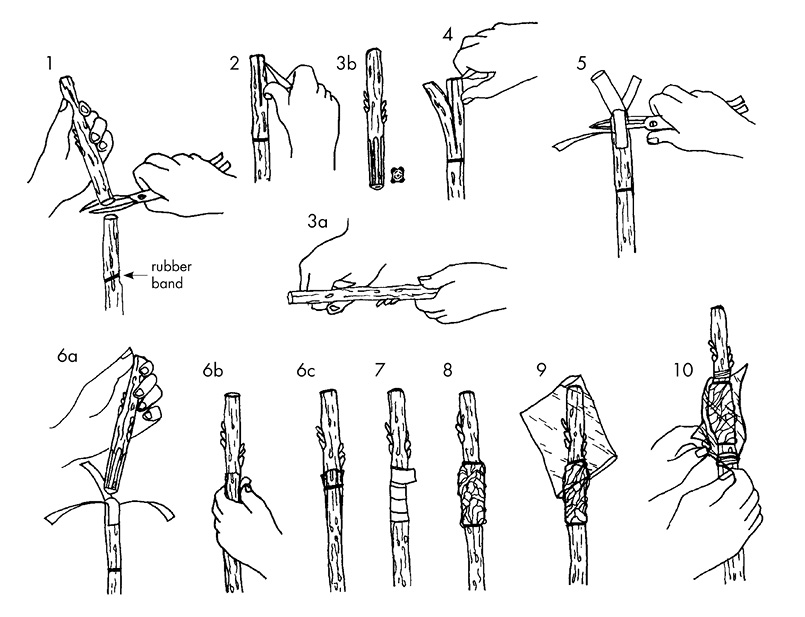Four Flap Grafting of Pecans
Many poor-producing seedling pecan trees are growing throughout Mississippi. Their productivity could be enhanced via grafting to a more desirable, improved variety. One such graft to employ is the four-flap graft.
The four-flap graft, also sometimes called a banana graft, is simple and does not require many materials. Homeowners, commercial growers, and hobbyists can use this grafting method with confidence because it has a good probability of success if done correctly. Optimum stock (trunk and limb) size for grafting is 3/8 inch to 1 inch in diameter. Nurseries commonly produce seedling trees of this size from planted nuts in 2 or 3 years. Seedling trees of this size that already exist in pastures or other outdoor environments also make suitable choices for grafting.
Although the graft works best if the graftwood (scion) and stock are the same size, the graft can be made with scions 25 percent larger or smaller than the stock. The four-flap graft is successful because more cambium contact is made between the scion and the stock than with any other grafting procedure. The cambium contact is necessary for callus formation and a successful graft union.
Collecting and Storing Scion Wood
One of the common reasons grafting is unsuccessful is the failure to properly collect and store graftwood. Collect the desired variety while the wood is dormant—December through February in Mississippi.
- Young tress produce vigorous growth and are generally excellent sources of scion wood. Do not collect scion wood that is 2 to 3 years of age. For best results, collect wood from the previous season’s growth.
- Collect scion wood from trees that don’t have diseases.
- Cut the scion wood into 6- to 8-inch sticks.
- Tie the sticks in bundles of 25.
- Identify each group with a tag or by some other method.
- Wrap scions in damp newspaper, then put into a plastic bag and seal. Store in a refrigerator until it is time to graft. Do not store graftwood in a freezer, and do not allow the scions to dry out.
Time to Graft
When the bark separates (slips) freely from the rootstock, grafting can begin. This usually occurs in mid-April in most parts of Mississippi. The four-flap method can be successfully used through the end of May.
Procedure
- Cut the stock straight across with sharp pruning shears at the point you want to make the graft. The stock should be about the same size as the graftwood. Place a small rubber band on the stock to be used later.
- Make four vertical incisions 2 to 3 inches long and equally spaced (quartered) around the circumference of the rootstock. Make sure the cuts go only through the bark and not into the wood.
- Choose a smooth, straight scion. Cut to about 6 inches in length, with two or three buds remaining. With a sharp knife, cut the scion on four sides, starting the cut about 2 inches from the bottom end. The cut should be made only through the bark. The end view will be square. Note: Many times, only three cuts can be made due to the size of the graftwood. This is acceptable, but only three equidistant incisions should be made on the rootstock.
- Pull the four flaps of bark down. This will expose 2 to 3 inches of white wood. Try not to touch the inside of the flaps or exposed surface of the scion.
- With sharp pruning shears, cut and remove the exposed wood (plug). Be careful not to touch, cut, or damage the four flaps.
- Insert the scion upright on the rootstock. Pull the four flaps in place to cover the four cut surfaces on the scion. Pull the rubber band up to secure the four flaps in place.
- Wrap the cut areas with grafting tape or other suitable material. Overlap each wrap only enough to provide a complete seal. As you wrap, move the rubber band up the scion and remove it.
- Cover the tape with a piece of regular household aluminum foil.
- Clip the corner of a polyethylene bag (pint or quart size) and carefully slip it down over the stock with the scion protruding through the bag.
- Tie the bag to the scion approximately 1 inch above the foil and to the stock 1 or 2 inches below the foil. You can use rubber bands, budding strips, string, masking tape, or other tapes to secure the polyethylene bag in place. The bag will keep the graft from drying out and also protect it from intruding rainfall.

After Care
Keep the graft scion from growing too vigorously throughout the first summer by removing growing tips. Do this several times during the season. This will cause a trashy or bushy trunk to develop, resulting in increased tree diameter and better overall tree establishment. This type of growth can be used as a “throttle” to regulate the growth rate of the graft. If the graft is growing slowly, remove more of the lateral growth on the stock. Should the graft make excessive growth that is vulnerable to breakage, allow the lateral growth to remain for an extended period. Normally, all the growth on the rootstock below the desired height of the bottom limb will be removed in 2 or 3 years.
The bag and foil may stay in place for the rest of the growing season. Remove it along with the tape the following winter or when the graft has fused sufficiently. Cut the tape soon after vigorous scion growth begins to prevent girdling of the stock and the scion.
Publication 3810 (POD-12-21)
Revised by Eric T. Stafne, PhD, Extension/Research Professor, Coastal Research and Extension Center.
The Mississippi State University Extension Service is working to ensure all web content is accessible to all users. If you need assistance accessing any of our content, please email the webteam or call 662-325-2262.


